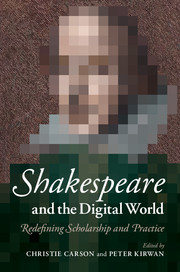Book contents
- Frontmatter
- Contents
- Notes on contributors
- Acknowledgements
- Shakespeare and the digital world
- Part I Defining current digital scholarship and practice
- Part II Defining current digital scholarship and practice
- 5 Internal and external Shakespeare
- 6 Shakespeare at a distance
- 7 ‘All great Neptune’s ocean’*
- 8 ‘From the table of my memory’*
- Half-time: A pause for reflection
- Part III Redefining the boundaries and practices of Shakespeare studies online
- Part IV Redefining the boundaries and practices of Shakespeare studies online
- Index
- References
5 - Internal and external Shakespeare
Constructing the twenty-first-century classroom
Published online by Cambridge University Press: 05 July 2014
- Frontmatter
- Contents
- Notes on contributors
- Acknowledgements
- Shakespeare and the digital world
- Part I Defining current digital scholarship and practice
- Part II Defining current digital scholarship and practice
- 5 Internal and external Shakespeare
- 6 Shakespeare at a distance
- 7 ‘All great Neptune’s ocean’*
- 8 ‘From the table of my memory’*
- Half-time: A pause for reflection
- Part III Redefining the boundaries and practices of Shakespeare studies online
- Part IV Redefining the boundaries and practices of Shakespeare studies online
- Index
- References
Summary
In 1951 Allardyce Nicoll and the University of Birmingham established the Shakespeare Institute in Stratford-upon-Avon, taking hold of a building called Mason Croft that had once belonged to a popular romance novelist named Marie Corelli and later served as an outpost for the British Council. Originally intended as an academic think tank for the Shakespeare Memorial Theatre – later to become the Royal Shakespeare Company – the newly established Shakespeare Institute soon made its presence known, hiring three founding Fellows (Reginald Foakes, Ernest Honigmann and John Russell Brown), starting up Shakespeare Survey and the International Shakespeare Conference, acquiring the full microfilm collection of the English Short Title Catalogue and opening its doors to postgraduate students wishing to study Shakespeare. More than sixty years later, despite major changes in the UK higher education system, much about the original vision for the Shakespeare Institute has remained the same, not least its commitment to cultivating new generations of Shakespeare scholars, teachers and practitioners through postgraduate teaching and research supervision. It remains an extremely tight-knit community, with students and academics travelling from all over the world to seek out a particular kind of intellectual and social experience that permeates the lecture hall, seminar rooms, library and even gardens of Mason Croft. While the building hasn’t been used as a private residence since 1941, it still very much feels like a home.
- Type
- Chapter
- Information
- Shakespeare and the Digital WorldRedefining Scholarship and Practice, pp. 63 - 74Publisher: Cambridge University PressPrint publication year: 2014
References
- 3
- Cited by



